Clothes don’t make the man
June is Lesbian, Gay, Bisexual and Transgender Pride month, what better time, then, to coming out? I like males. I like them so much that sometimes I would like to be a man. And to be gay. So I guess we can say he wasn’t very far from the truth the visitor who, while trying to open my eyes to the deformations of a History written by the “whites”, paused for a moment to ask me: “Are you a lesbian?” assuming it because of my short hair.
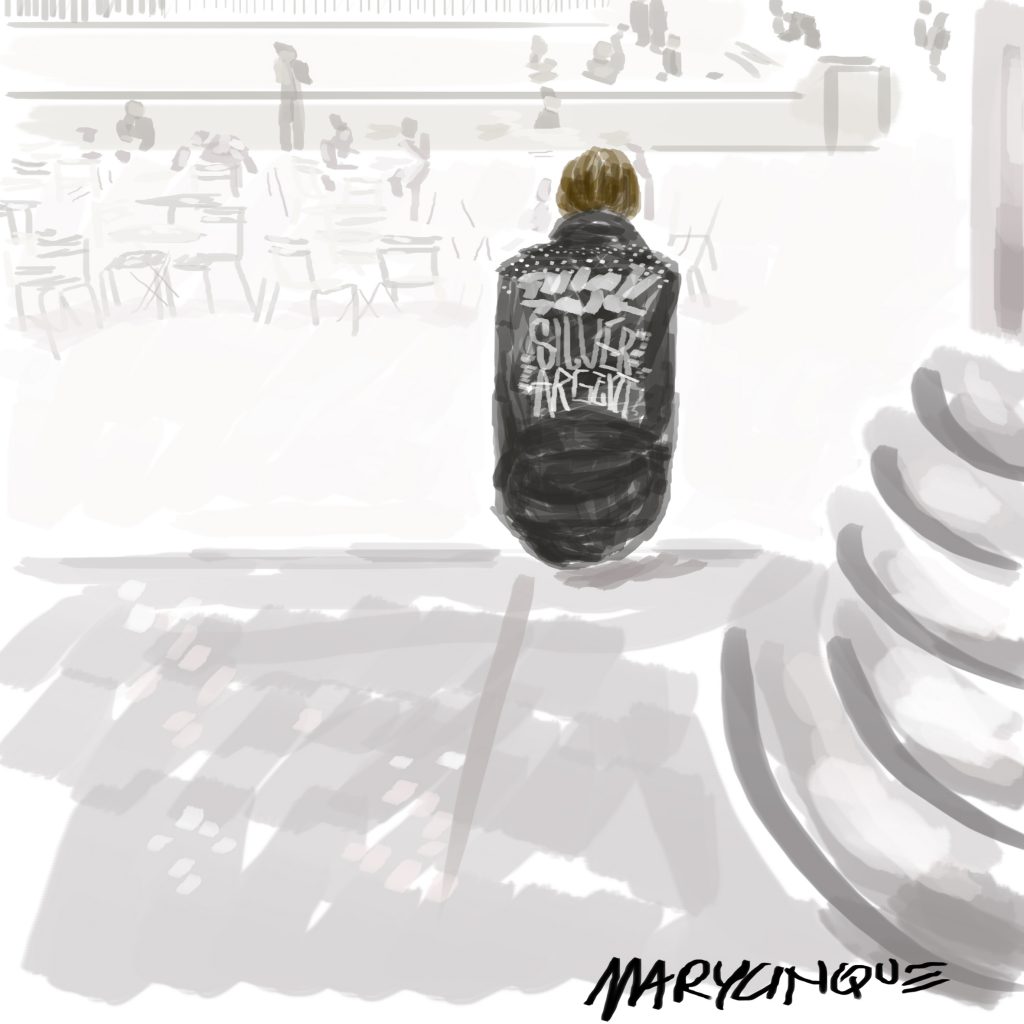

“Desire, love, identity Exploring LGBTQ histories” opened few weeks ago at the British Museum, inviting visitors to look at historical pieces from the museum’s collection with fresh new eyes, and featuring some contemporary badges, the ideal medium for communicating, fighting commonplace and inviting to dialogue, as my favorite says: “Assume nothing”. I never do it. That is why one day I stopped in front of the Swedenborg society‘s stall, not exactly my cup of tea but, among the books dedicated to the philosopher, scientist, inventor, astronomer, mathematician, parliamentary figure and visionary to whom the society is dedicated, a glanced a paperback and was “Moab is my washpot,” the autobiography of Stephen Fry’s first twenty years.
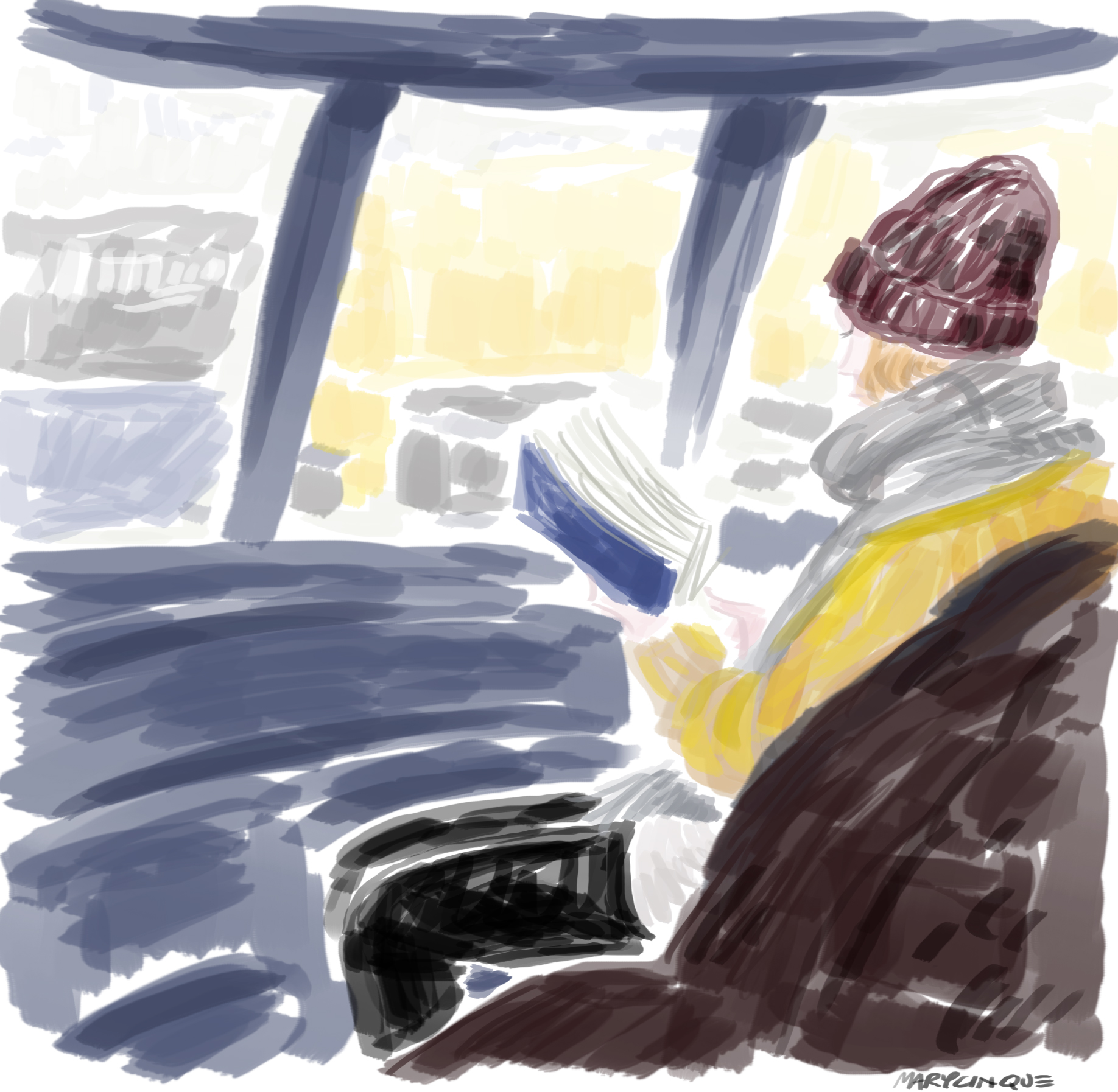
As I became aware of Stephen Fry’s existence, it’s a funny story that deserves a digression as it starts and ends with a book. Everything began in a bookstore in Naples where I noticed, relegated to the lowest shelf, almost on the floor, a series of books with a very elegant covers design made of vertical bands of two shades of the same color, like a wallpaper, and with the drawing of a dachshund as an emblem. How could I resist? I took one and read on the cover page of Wodehouse and his tales of Jevees the butler. Okay, dachshund, butler, English humor: I was won over. I bought a copy and you can imagine my despair when, back to the very same library to buy another one, I found out that they weren’t selling that book series anymore. Evidently a niche, or even better, a low shelf product. But fortune favours the bold and the visitors of used books stalls and shortly after, at Port’Alba with my sister (infected by Jevees virus herself), what the joy in seeing ten tomes of Jevees’ adventures, unmistakably part of the library of a cute old man who has already gone to a better life! Our passion led us to rediscover Stephen Fry who played the butler on telly and reminded us that we had already admired him in his interpretation of Oscar Wilde.
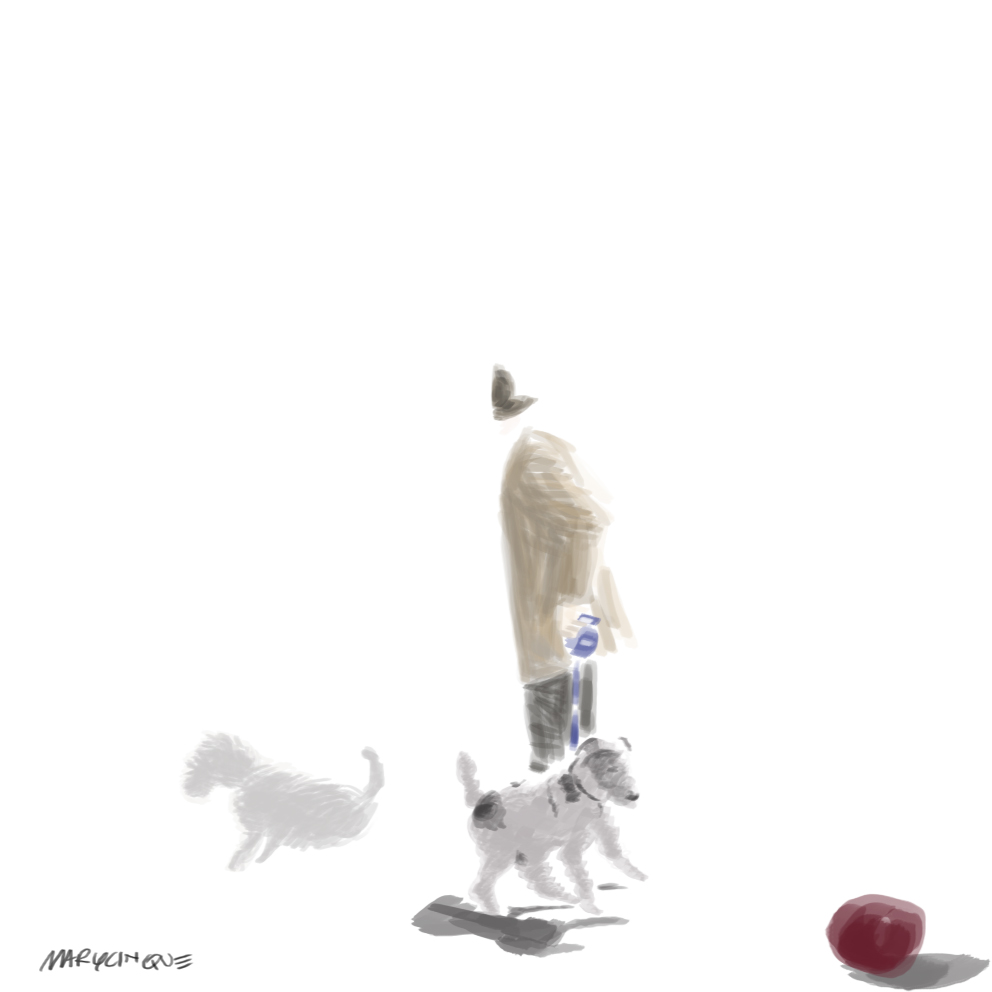
Oscar Wilde is one of the artists featured in “Queer art” exhibition at Tate Britain, where the door of the cell where he was imprisoned is on display. There are other cages, such as those painted by my beloved Bacon or the metaphorical ones, imposed by the prigs but, as this exhibition testifies, were, from time to time, forced, disfigured, ignored. This is the case of the joyous and vital David Hockney (a superb portraitist of dachshunds, incidentally) whose work I admired in his great solo show in the same venue. Recently at the British Museum were exhibited his engravings of the series “Illustrations for Fourteen Poems from C.P. Cavafy “, while two of his lithographs are still visible in the show “The American Dream pop to the present “.

After the Saturday night attacks at London Bridge and Borough Market, it is even more urgent to give yourself at least three free hours to spend in Wolfang Tilmans solo show at Tate Modern, which the artist curated as well, addressing a number of issues including the shrinking of self-expression spaces. It’s one of the finest things I’ve seen so far, for the sweet and passionate look to the male body, as well. A show full of humanity.
Giulia, our philosopher à porter, visited Queer British Art 1861-1967 and here they are her illuminating words about it. “The exhibition Queer British Art 1861-1967 celebrates the anniversary of fifty years since the partial decriminalization of male homosexuality. More than just being a chronological or thematic analysis of the works of artists who were themselves gays or lesbians, this exhibition goes really deep into their often intense private lives, memories and relationships. By collecting together these experiences represented in the works of art, the show seems like a journey through one of the oldest questions of human’s history: the nature of Love.
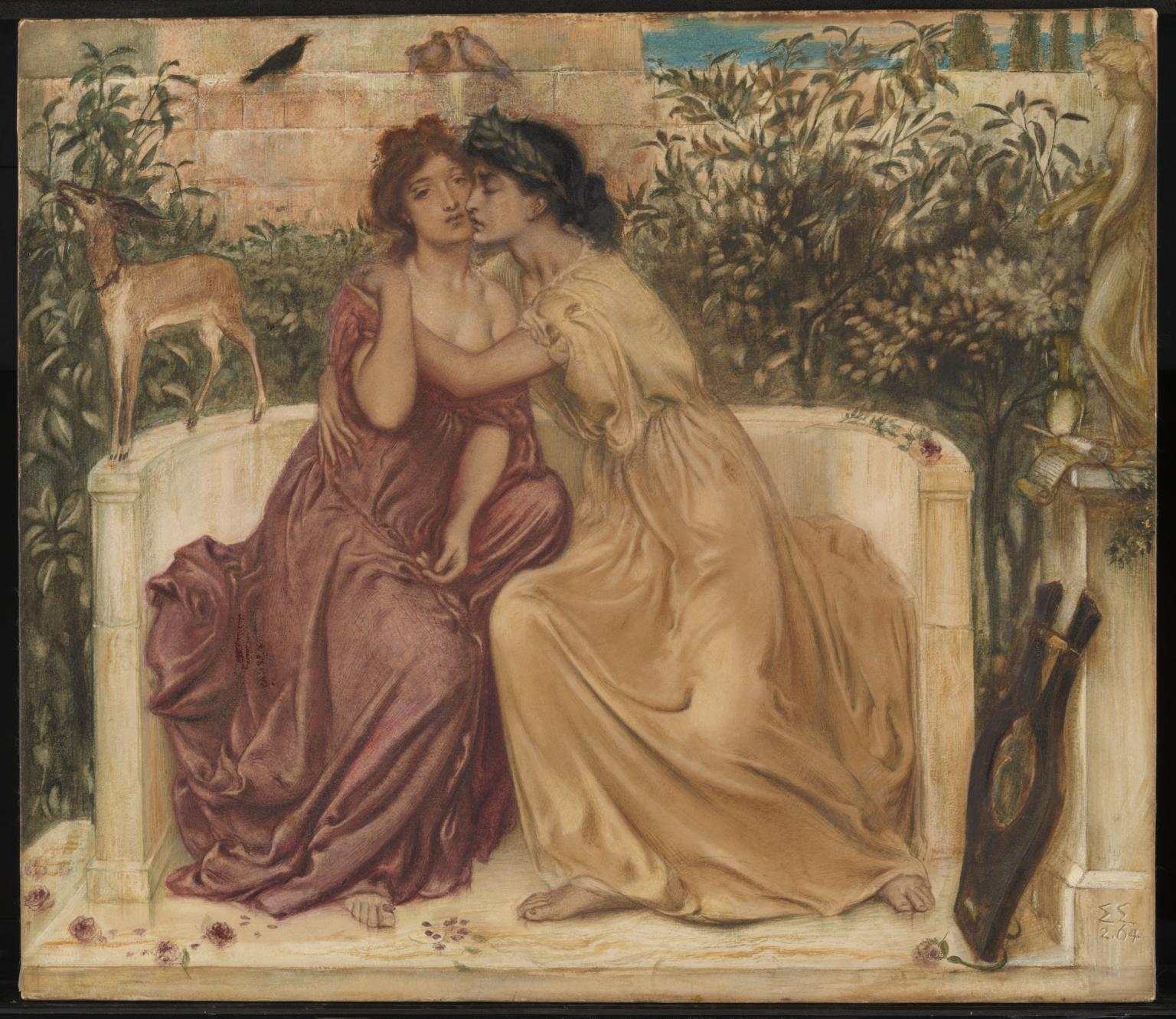
- Simeon Solomon Sappho and Erinna in a Garden at Mytilene, 1864
One famous answer to the question about love is found in Plato’s Symposium – a work which is frequently quoted in the exhibition for being also a defense of homosexual love. In this dialogue, Plato describes Love (Eros) as a demon, a creature that is half human and half divine. Love is therefore, ambiguous, in the middle between two opposites. Love is also told to be the son of Poros (expedient) and Penia (poverty): he comes from a lack, a need, a tension toward something. Love is therefore depicted as a struggle, an experience of something unbalanced that seeks stability, a strong desire. Moreover, Love is figuratively associated with Philosophy: the love for knowledge. Plato and Socrates often reflect on the puzzling condition to be in the middle of ignorance and absolute truth. In love, as in the pursuit of knowledge, one knows what he is missing, he can feel the object of his desire, but he will never satisfy his need in a permanent and certain way. For this reason, Love is, in the end, an inquiry, an exploration, a journey through a land of uncertainty and fluidity. Ultimately, love is research and infinite speculation.
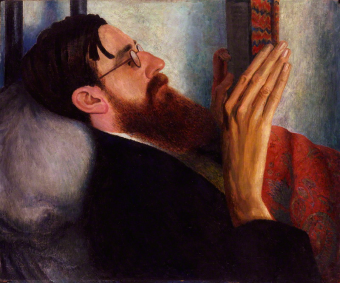
- D. Carrington Lytton Strachey, 1916
It seems possible to notice that, although every artist in the exhibition represents different subjects, feelings and visions of life, they are all close in this idea of love. From this perspective, Queer Art shows the tremendous and uncomfortable place that love occupies in our lives by highlighting its founding value for our individual identity. Most of the artists that appear in this show experienced unbearable humiliations in order to live according to their identity, which happened to be not simply or plainly one of the two alternatives offered by the society: male or female. The awareness to have an ambiguous, fluid and in any case “irregular” identity, fostered the creativity of these men and women. They produced powerful works which are real mirrors of their souls, and they reveal the most profound dimension of their inquiry about love, hence about their own identity.
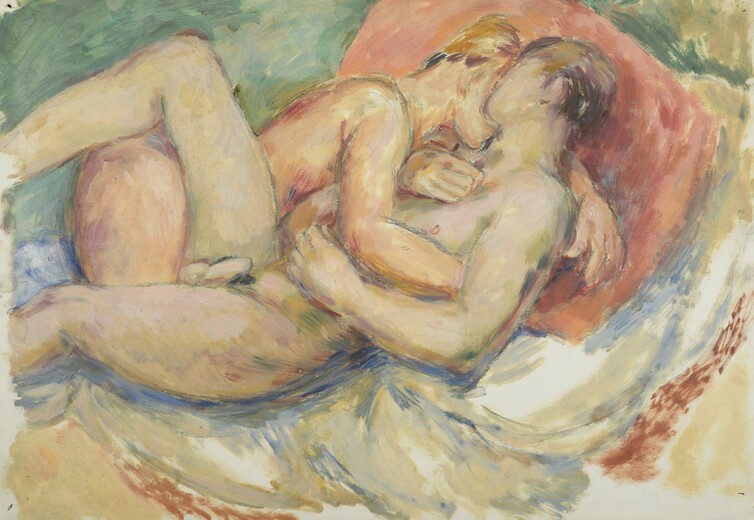
- D. Grant Erotic Embrace, 1950
These suggestions resonates in the choice of the word “queer”. By being out of the “norm” these artists, but more importantly their works, tell us how the research of one’s own identity is an ongoing journey, always redefined by cultural discourses, representations and self-representations.
Queer, inexplicable is the effort to understand and embrace this complexity, to discover oneself. Queer, very strange ,is the search for love, so fluid, elusive, irregular. The two attempts are inseparable, strange, often painful but indeed essential to life.
Giugno è il mese del Lesbian, Gay, Bisexual e Transgender Pride, quale momento migliore, quindi, per fare outing? Mi piacciono i maschi. Mi piacciono talmente tanto che a volte vorrei essere un uomo. Gay. Quindi non ci è andato molto lontano quel visitatore che, mentre cercava di aprirmi gli occhi sulle deformazioni di una Storia scritta dai “bianchi” si è fermato un attimo per chiedermi: ”Sei lesbica?”, evidentemente indotto a pensarlo dai miei capelli corti.
Qualche settimana fa, al British Museum, ha aperto la mostra “Desire, love, identity
exploring LGBTQ histories” che fornisce chiavi di lettura per guardare senza pregiudizi pezzi storici della collezione del museo, fino ad arrivare alle più moderne pins, mezzo ideale per comunicare, combattere i luoghi comuni e invitare al dialogo, come fa la mia preferita che recita: “Assume nothing”. Io non lo faccio mai. Sarà per questo che un giorno mi sono fermata davanti alla bancarella di libri della Swedenborg society, non esattamente il mio genere ma, tra i libri dedicati al philosopher, scientist, inventor, astronomer, mathematician, parliamentary figure and visionary a cui la fondazione è dedicata, un paperback ochieggiava ed era “Moab is my washpot”, l’autobiografia dei primi vent’anni di Stephen Fry. Come io sia venuta a conoscenza dell’esistenza di Stephen Fry è cosa che merita una digressione che da un libro parte e a un libro torna. Tutto comincia nella libreria Ubik di Napoli dove noto, relegata nello scaffale più basso, quasi sul pavimento, una collana di libri dalle copertine molto eleganti, a bande verticali di due tonalità del medesimo colore, come una carta da parati, e con il disegno di un cane bassotto come emblema. Come potevo resistere? Ne prendo uno e leggo sulla quarta di copertina che trattasi di Wodehouse e della sua serie dedicata la maggiordomo Jevees. Ok, bassotto, maggiordomo, umorismo inglese: ero in trappola. Ne compro una copia e quale la mia tristezza quando, tornata nella medesima libreria per comprarne un’altra, scopro che la collana non è più disponibile. Evidentemente un prodotto di nicchia, anzi, di scaffale basso. Ma la fortuna aiuta gli audaci e i visitatori di bancarelle di libri usati e, poco tempo dopo, in giro per Port’Alba con mia sorella (quando oramai il virus aveva contagiato anche lei) quale la gioia alla vista di ben dieci volumi delle avventure di Jevees, evidentemente parte della biblioteca di un simpatico vecchietto ormai passato a miglior vita! La nostra passione ci ha portato così a riscoprire Stephen Fry che ha impersonato il maggiordomo sullo schermo e a ricordarci di averlo già ammirato nella sua interpretazione di Oscar Wilde.
Oscar Wilde è uno degli artisti di cui da conto la mostra “Queer art” alla Tate Britain, dove è esposta anche la porta della cella in cui fu imprigionato. Ci sono altre gabbie, come quelle dipinte dal mio amatissimo Bacon o quelle metaforiche, imposte dai benpensanti di tutte le epoche che qui si racconta come siano state, di volta in volta, forzate, sconfessate, ignorate. E’ il caso del gioioso e vitale David Hockney, (un superbo ritrattista di cani bassotti, per inciso) i cui lavori ho potuto ammirare anche nell’ antologica a lui dedicata nella medesima sede. Recentemente al British Museum sono state esposte le sue incisioni della serie “Illustrations for Fourteen Poems from C.P. Cavafy”, mentre sono ancora visibili due sue litografie nella mostra “The American Dream pop to the present”.
Dopo gli attacchi di sabato sera al London Bridge e a Borough Market diventa ancora più urgente, secondo me, regalarsi almeno tre ore nella mostra di e su Wolfang Tilmans alla Tate Modern che affronta numerosissimi temi tra cui il ridursi degli spazi di libera espressione di sè. E’ una delle cose più belle che ho visto finora, anche per lo sguardo dolce e appassionato sul corpo maschile. Una mostra piena di umanità.
La nostra filosofa à porter, Giulia, ha visitato Queer British Art 1861-1967 ed eccola, nelle sue parole illuminanti. “La mostra celebra l’anniversario dei cinquant’anni dopo la parziale depenalizzazione dell’omosessualità maschile. Più che essere solo un’analisi cronologica o tematica delle opere di artisti che erano gay o lesbiche, questa mostra va davvero in profondità nella loro intensa vita privata, nei ricordi e nelle relazioni. Raccogliendo queste esperienze rappresentate nelle opere d’arte, la mostra è come un viaggio attraverso una delle questioni più antiche della storia umana: la natura dell’Amore.
Una famosa risposta alla domanda sull’amore si trova nel Simposio di Platone – un’opera spesso citata nella mostra per essere anche una difesa dell’amore omosessuale. In questo dialogo, Platone descrive l’amore (Eros) come un demone, una creatura che è metà umana e metà divina. L’amore è dunque ambiguo, in mezzo tra due opposti. L’amore è anche detto essere figlio di Poros (espediente) e Penia (povertà): viene quindi da una mancanza, da una necessità, da una tensione verso qualcosa. L’amore è descritto come una lotta, un’esperienza di qualcosa di sbilanciato che cerca la stabilità, un forte desiderio. Inoltre, l’amore è associato figurativamente alla filosofia: l’amore per la conoscenza. Platone e Socrate riflettono spesso sulla condizione sconcertante di essere nel mezzo fra ignoranza e verità assoluta. Nell’amore, come nel perseguimento della conoscenza, l’uomo sa cosa gli manca, può percepire l’oggetto del desiderio, ma gli ѐ impossibile soddisfarlo in maniera permanente e certa. Per questo, l’amore è, alla fine, un’indagine, un’esplorazione, un viaggio attraverso una terra di incertezza e fluidità. In definitiva, l’amore è ricerca e speculazione infinita.
Sembra possibile notare che, sebbene ogni artista della mostra rappresenti soggetti, sentimenti e visioni differenti della vita, essi siano tutti vicini a questa idea di amore.
Da questa prospettiva, Queer Art mostra il posto ingombrante e scomodo che l’amore occupa nella nostra vita, evidenziandone il valore fondante per l’identità individuale. La maggior parte degli artisti che appaiono in questa mostra hanno sperimentato umiliazioni insopportabili per vivere secondo la loro identità, che non coincideva semplicemente o chiaramente con una delle due alternative offerte dalla società: maschio o femmina. La consapevolezza di avere un’identità ambigua, fluida e comunque “irregolare”, ha incoraggiato la creatività di questi uomini e donne. Essi hanno prodotto opere potenti che sono veri specchi delle loro anime e rivelano la dimensione più profonda della loro ricerca sull’amore, quindi sulla propria identità.
Queste suggestioni risuonano nella scelta della parola “queer”. Essendo fuori dalla “norma” questi artisti, ma soprattutto i loro lavori, ci dicono che la ricerca della propria identità ѐ un cammino continuo, sempre ridefinito da discorsi culturali, rappresentazioni e auto-rappresentazioni. Strano, inspiegabile ѐ lo sforzo di comprendere e abbracciare questa complessità, per trovare se stessi. E strana, stranissima ѐ la ricerca dell’ amore, cosi fluido, sfuggente, irregolare. Le due imprese sono inscindibili, strane, spesso dolorose ma davvero essenziali alla vita.
-----------------Published on 06-Jun-2017
Tags: art, British, Eros, exhibition, homosexuality, love, Penia, philosophy, Plato, Poros, Queer, Queer British Art 1861-1967, Sappho, Symposium
Clothes don’t make the man
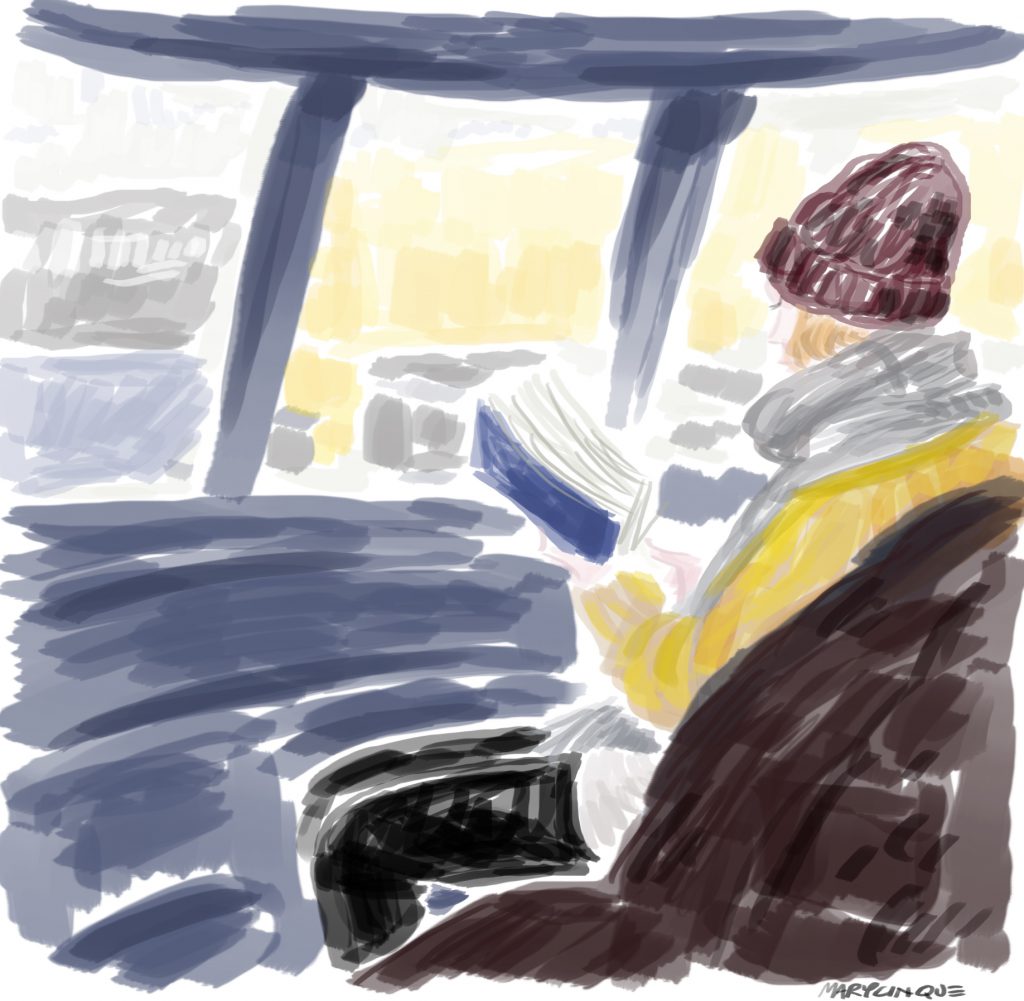
Stephen Fry, P.G. Woodehouse, and Hockney and his Bassotto’s (we have Bassotto’s ourselves, unfortunalely no Hockney’s yet..) : Mary, we are on the same page again and again! Last wk, I stayed for a few days at Marina del Cantone again (near i Galli..), paradice. Ciao, James
It’s never too late! 🙂